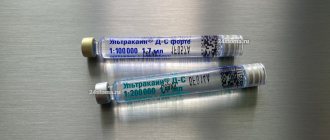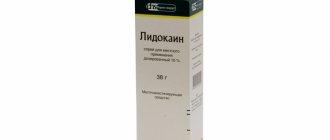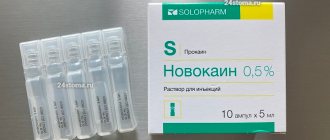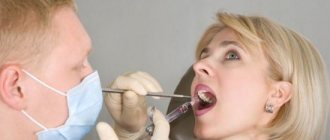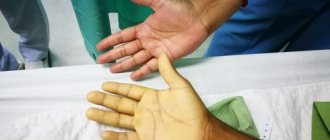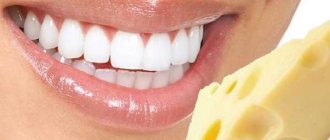In women, after the birth of a child, the condition of their teeth deteriorates greatly. This is due to the fact that during gestation the mother transferred most of the calcium to the baby, and after birth she continues to give away the valuable mineral through breast milk. As a result, the mother's teeth are destroyed. In this case, you need to go to the hospital, where painkillers are often used during procedures.
Ultracaine is a modern anesthetic that is often used in dentistry. The drug acts locally and exhibits a therapeutic effect 1.5 - 3 minutes after administration of a small dose. The anesthetic effect lasts for 1 to 5 hours. Nursing mothers are wondering whether they can use the medication for dental treatment. According to doctors, this is a safe drug for lactation.
Description of dosage forms
Ultracaine is a transparent solution with a neutral aroma, which is packaged in carpules (glass cartridge capsules). To administer it, you need a special syringe into which a cartridge and a thin needle are installed. The injection is quite painless due to the small diameter of the needle. Usually, even small patients tolerate the procedure well. The needle and cartridge are used once, after which they are disposed of.
The drug is based on articaine and adrenaline (epinephrine, which constricts blood vessels). Additional components: sodium chloride, distilled water, sodium pyrosulfate, etc. d. The drug has a pronounced anesthetic effect, which manifests itself quite quickly and lasts for at least 60 minutes.
Ultracaine is presented in 3 forms, which have their own trade name:
- Ultracaine DS forte with adrenaline concentration – 1:100000. The drug helps to achieve a pronounced anesthetic effect during dental treatment. This form of medication is contraindicated for hypertension, severe diseases of the heart and blood vessels, thyroid gland, and asthma.
- Ultracaine D does not contain adrenaline. The dosage form contains no preservatives that stabilize anesthetics containing epinephrine. Therefore, it is recommended for patients prone to allergies and asthmatics. In addition, the medication is allowed to be used for diseases of the thyroid gland, serious illnesses of the heart and blood vessels. However, the anesthetic effect of Ultracaine without adrenaline lasts about 20 minutes.
- The drug marked DS has an epinephrine concentration of 1:200,000. This is the optimal dosage form for pregnant and lactating patients, people with heart disease in the compensated stage. It is not recommended to use the drug for asthmatics and people with a diseased thyroid gland.
In addition, it should be noted that after using Ultracaine it is not recommended to perform activities related to reaction speed and concentration for 5 hours.
A local anesthetic drug is used in dentistry for the following procedures:
- Dental filling.
- Removing a nerve from a tooth.
- Surgical operation to remove a tooth without complications.
- Orthopedic work (installation of crowns, veneers, removable dentures, etc.).
- Treatment of wounds, abscesses on the oral mucosa, suturing.
- Dental work of any complexity for patients with severe pain tolerance.
Ultracaine is used for the treatment and removal of teeth during pregnancy, breastfeeding, and also in patients of a younger age category.
Local anesthesia. Ultracaine
When carrying out medical manipulations, patients want it to happen as comfortably and painlessly as possible, since many, for fear of discomfort during the procedure, put off solving skin problems for a long time. Anesthesia is used to reduce pain during the procedure.
When carrying out medical manipulations, patients want it to happen as comfortably and painlessly as possible, since many, for fear of discomfort during the procedure, put off solving skin problems for a long time. Anesthesia is used to reduce pain during the procedure.
Anesthesia is a decrease in the sensitivity of tissues to various irritants, which is achieved by briefly blocking the transmission of signals along nerve endings with the help of painkillers. Anesthesia is divided into general and local. General anesthesia (anesthesia) is most often used in surgery, and types of local anesthesia such as infiltration and application are widely used in dermatology.
Infiltration anesthesia is usually used for the removal of skin lesions, such as papillomas, moles, viral warts, keratomas and others, as well as for skin biopsy. The drug is injected directly into the site of the upcoming procedure to make the procedure as comfortable as possible. For pain relief, the drugs most often used are lidocaine or ultracaine.
Local anesthesia with ultracaine and lidocaine is quite safe due to the administration of small doses of the drug and short-term blocking of the transmission of pain impulses along nerve fibers.
The choice of drug for local infiltration anesthesia is determined by the attending physician during a consultation, taking into account all contraindications and drug intolerance.
The advantages of infiltration anesthesia are a long-lasting analgesic effect, the safety of the method, harmlessness to the body, simplicity and relative cheapness.
Contraindications include:
— the presence of an inflammatory process at the injection site;
- diseases of the nervous system;
- hemorrhagic syndrome;
- intolerance to local anesthetic, allergic reactions in the past to the active substance of the anesthetic;
- lack of proper contact with the patient (deaf-mute, intoxicated).
Also, before the procedure, you must inform the doctor about the presence of pregnancy or lactation.
Ishpakhtina Kira Gennadievna
Dermatovenerologist, pediatric dermatologist, cosmetologist, candidate of medical sciences
Make an appointment LLC MC "Newmed" Chelyabinsk, Komsomolsky Prospekt, 36B LLC MC "Newmed Plus" Chelyabinsk, 40-letiya Oktyabrya, 15, building 1
I agree with the terms of the Personal Data Processing Policy
Blokhina Yulia Vladimirovna
Dermatovenerologist, cosmetologist, trichologist
Make an appointment LLC MC "Newmed" Chelyabinsk, Komsomolsky Prospekt, 36V LLC MC "Newmed Plus" Chelyabinsk, 40-letiya Oktyabrya, 15, building 1
I agree with the terms of the Personal Data Processing Policy
Romanov Sergei Georgievich
Dermatovenerologist, highest qualification category
Make an appointment LLC MC "Newmed" Chelyabinsk, Komsomolsky Prospekt, 36V LLC MC "Newmed Plus" Chelyabinsk, 40-letiya Oktyabrya, 15, building 1
I agree with the terms of the Personal Data Processing Policy
Paushkina Ekaterina Vasilievna
Dermatologist, pediatric dermatologist, cosmetologist
Make an appointment
I agree with the terms of the Personal Data Processing Policy
Bogdanova Irina Sergeevna
Dermatovenerologist, pediatric dermatologist, cosmetologist
Make an appointment
I agree with the terms of the Personal Data Processing Policy
Aibulatova Valentina Anatolevna
Dermatovenerologist, pediatric dermatologist, cosmetologist
Make an appointment
I agree with the terms of the Personal Data Processing Policy
Rodina Ekaterina Vladimirovna
Dermatovenerologist, cosmetologist, trichologist
Make an appointment
I agree with the terms of the Personal Data Processing Policy
Stalmakov Alexander Lvovich
Dermatovenerologist of the first qualification category
Make an appointment
I agree with the terms of the Personal Data Processing Policy
Dermatologist appointment price
Consulting services
| Service code | Name of medical service | Price | |
| B01.008.001 | Primary appointment (examination, consultation) with a dermatologist | 1350 | Make an appointment |
| B01.008.002 | Repeated appointment (examination, consultation) with a dermatologist | 850 | Make an appointment |
| B01.008.001 | Primary appointment (examination, consultation) with a pediatric dermatologist | 1350 | Make an appointment |
| B01.008.002 | Repeated appointment (examination, consultation) with a pediatric dermatologist | 850 | Make an appointment |
| B01.008.001 | Appointment (examination, consultation) with leading dermatologist Yu.V. Blokhina, Ph.D. Ishpakhtina K.G. primary | 1550 | |
| B01.008.002 | Appointment (examination, consultation) with leading dermatologist Blokhina Yu.V., Stalmakova A.L., Ph.D. Ishpakhtina K.G. repeated | 1000 | |
| B01.008.001 | Appointment (examination, consultation) with a dermatovenerologist with digital dermatoscopy of a single neoplasm | 1400 |
Treatment and diagnostic procedures
| Service code | Name of medical service | Price |
| A03.01.001 | Digital dermatoscopy of the whole body with mapping (RDS-2) + consultation with a dermatologist (duration 90 minutes) | 6600 |
| A03.01.001 | Repeated digital dermatoscopy of the whole body with mapping (RDS-2) + consultation with a dermatologist (no more than 6 months from the last examination) | 4400 |
| A03.01.001 | Dermatoscopy (Skin examination under magnification) RDS-2 | 410 |
| A11.01.001 | Skin biopsy | 4000 |
| A11.01.009 | Skin scraping | 300 |
| A16.01.017 | Removal of benign skin tumors (molluscum contagiosum, keratoma, wart, hemangioma, dilated vessel, telangiectasia, papilloma) using the radio wave method | 200 |
| A24.01.004 | Cryodestruction (molluscum contagiosum keratoma warts hemangioma dilated vessel telangiectasia papilloma) | 420 |
| A.22.01.003 | Laser removal of skin formations (up to 5 pieces per element) | 600 |
| A.22.01.003 | Laser removal of skin formations (more than 5 pieces per element) | 500 |
| B01.003.004.001 | Local anesthesia (including the cost of the drug (lidocaine)) | 330 |
| B01.003.004.004 | Topical anesthesia (cream including the cost of the drug) | 800 |
| B01.003.004.011 | Combined anesthesia (including the cost of drugs) | 700 |
| B01.003.004.001 | Local anesthesia (including the cost of the drug (ultracaine)) | 660 |
We are waiting for you for consultations and procedures at Newmed MC!
Application of anesthetic
A large number of modern dental clinics use Ultracain for pain relief. This is due to the fact that this drug is more effective than classical anesthetics (Lidocaine, Novocaine). In addition, the drug is safe and practically does not cause negative effects.
The dose of the medication depends on the depth and duration of the procedure. The dentist determines the required dose of medication for each patient separately. However, when making a decision, the doctor is guided by the following rules regarding the dose of the drug:
- To remove 1 or several teeth located nearby, 1.7 ml of solution is injected. To remove several teeth located far away, 2 injections (1.7 ml each) are given near each one. If after administration of the solution the therapeutic effect does not appear, then the same dose is administered, but into one tooth. In the absence of anesthesia, Ultracaine is abandoned and a complete blockade is carried out.
- When grinding teeth, 1 ml of solution is injected under the crown near the damaged tooth.
- When cutting or suturing the palate, 0.1 ml of the drug is injected near the damaged area.
Adults are prohibited from administering more than 7 mg/1 kg of the drug during treatment procedures. The normal dosage of the drug, which is well tolerated by patients, is about 12.5 ml. The child is prohibited from administering more than 5 mg/1 kg. Ultracaine is approved for use in children over 4 years of age.
Precautionary measures
The anesthetic is contraindicated under the following conditions:
- Hypersensitivity of Ultracaine components. Sometimes patients are allergic to articaine, adrenaline, etc. To avoid negative effects, allergy tests are done before using the drug. The safest solution in ampoules without adrenaline.
- Diseases of the heart and blood vessels. The drug is contraindicated in patients with tachycardia, tachyarrhythmia, hypertension, acute functional heart failure.
- Taking β-blockers. Ultracaine should not be used in combination with non-selective beta-blockers.
- Patients under 4 years of age. The solution is contraindicated in children, as it has not been tested in this age category.
During pregnancy and lactation, the drug is not contraindicated.
Sometimes the medicine provokes negative reactions:
- hypertension (in response to adrenaline);
- breathing disorders, consciousness, muscle spasms;
- decreased visual acuity, diplopia (split objects), blindness;
- nausea, vomiting;
- hypotension, increased heart rate;
- skin rash, itching, nettle fever, inflammation of the conjunctival membrane of an allergic nature, swelling, etc.;
- with bronchial asthma, attacks of vomiting, diarrhea, asthmatic attack, etc. occur.
With an excessive increase in the dose of the solution, the likelihood of psychomotor agitation, disorders of consciousness, and vertigo (dizziness) increases. If such signs appear, you should discard Ultracaine and ventilate the room where the victim is located. If you have difficulty breathing, you must use an oxygen mask.
Ultracaine for breastfeeding
According to doctors, Ultracain is allowed to be used during breastfeeding. This is due to the fact that modern anesthetic is completely eliminated from the body after 4–5 hours. After administration of the solution, the concentration of articaine in milk is minimal, from this doctors concluded that the drug will not harm the baby during feeding. The amount of adrenaline in Ultracaine DS is also low, and therefore the mother and newborn are safe.
If the mother is still worried, then she can feed the baby before visiting the dentist. Then after 4–5 hours the drug will be completely eliminated from the body. During this period of time, you can feed the baby with formula.
Thus, Ultracaine is a safe drug that is approved for nursing mothers during the treatment of dental diseases.
The dentist will determine whether the woman is allergic to the components of the drug and select the dose of the medication depending on the depth of penetration and duration of the procedure. If there are contraindications, the doctor will select a more suitable anesthetic. Subscribe to our VKontakte group
Is it possible to use local anesthesia during dental treatment while breastfeeding?
In fact, it is not worth neglecting “dental” problems, leaving their solution until the end of lactation. Because even seemingly harmless symptoms may indicate an inflammatory process or caries, untimely treatment of which can lead to serious complications, including tooth extraction.
To prevent this, a woman should consult a dentist as soon as possible at the first discomfort in the oral cavity.
IMPORTANT. At the very beginning of the appointment, you should definitely warn the doctor that the woman is breastfeeding.
One of the biggest fears among breastfeeding mothers is the use of anesthesia during dental treatment. In fact, the need for its use is largely exaggerated and is subject to discussion with the doctor in each specific case. By examining the oral cavity, the dentist will identify problems and indicate the likelihood of solving them without anesthesia. Indeed, sometimes for successful tooth treatment it is enough to endure the painful sensations for only a few seconds.
However, some procedures require the use of local anesthesia:
- opening of canals;
- tooth extraction;
- cyst cleaning;
- installation of pins.
In this case, it is important to find out from the dentist how quickly treatment is needed, and whether it can be postponed until breastfeeding is completed. If the problem requires an immediate solution, and the doctor insists on using local anesthesia, you should not refuse.
Sometimes after treatment or removal, the dentist prescribes a course of antibiotics. In this case, it would be useful to remind the doctor once again that the woman is breastfeeding, so that the doctor can select a drug that is most compatible with lactation. If this is not possible, while taking antibiotics, the baby should be fed pre-expressed (frozen) milk, and the mother herself should continuously maintain its production through regular expression.
IMPORTANT. Delaying treatment only aggravates dental problems, and chronic toothaches can provoke psycho-emotional stress, which has a detrimental effect on the production of breast milk.
